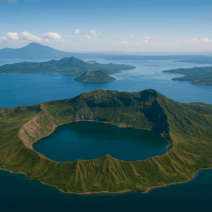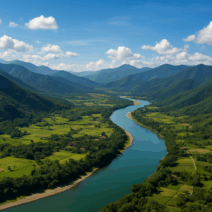QUICK SUMMARY
A guide to Camarines Norte’s major festivals, from the lively Bantayog Festival to the unique Pabirik and the devotion-filled Semana Santa traditions in Daet and beyond.
Camarines Norte is one of Bicol’s most culturally expressive provinces, and its festivals reflect the region’s deep blend of faith, coastal identity, and artistic pride. This province thrives on community gatherings: colorful street dances, centuries-old rituals, and celebrations honoring both people and the land. Whether linked to history, religion, or local livelihood, each festival tells a story that reveals the province’s vibrant soul.
This long-form guide explores Camarines Norte’s most notable festivals, the traditions behind them, and why they continue to draw visitors from across the Philippines.
Bantayog Festival
The Bantayog Festival is the most iconic celebration in Camarines Norte. Held every April in Daet, it commemorates the province’s rich history and the heroes who helped shape national identity. The festival was named after the Bantayog ng mga Bayani, the country’s first monument honoring José Rizal, built in Daet in 1898.
During the celebration, visitors witness a blend of cultural performances, folk dances, and historical reenactments. The streets fill with bright costumes reflecting both pre-colonial and Spanish-era influences. Artisans showcase traditional crafts, while food fairs highlight Bicol delicacies and homegrown specialties. The atmosphere is a lively mix of storytelling, pride, and community belonging, making the Bantayog Festival an essential highlight for any traveler exploring Camarines Norte.
Pabirik Festival
Held in the town of Paracale every February, the Pabirik Festival pays tribute to the area’s long association with gold mining. Paracale has been known for gold deposits for centuries, and the festival’s name comes from the pabirik, a gold-panning tool used by miners.
The celebration features a symbolic street dance that mimics the motions of gold panning, blending artistic movement with the rhythms of traditional mining life. Beyond the dances, local exhibits showcase mining artifacts, artisanal jewelry, and stories from mining families whose livelihoods have defined Paracale’s identity. The festival is both a cultural preservation effort and a recognition of the resilience of the mining community.
Mambulawan Festival
In Jose Panganiban, the Mambulawan Festival honors the town’s own mining heritage. The word “mambulawan” refers to someone who gathers resources from the earth, a fitting name that captures the community’s deep ties to mineral extraction. Held every October, the festival celebrates not just mining but also the town’s history, natural resources, and the craftsmanship of its people.
Street performances reenact the process of resource gathering, while trade fairs highlight local products, including handicrafts, seafood, and agricultural goods. The festival is a testament to how Jose Panganiban blends tradition with modern development and remains a meaningful gathering for locals and visitors alike.
Vinzons Town Fiesta
Vinzons is known for its religious devotion and its strong sense of community, which comes alive during its town fiesta every November. The celebration honors St. Peter the Apostle, the town’s patron saint, and features processions, choral performances, and celebrations that highlight Vinzons’ heritage as the birthplace of Wenceslao Q. Vinzons, a national hero.
Local families open their homes to welcome guests, creating an atmosphere rooted in hospitality and shared meals. The fiesta also includes parades, civic programs, and a lively atmosphere of gratitude and reflection.
Daet’s Semana Santa Traditions
While Holy Week is observed nationwide, Daet’s Semana Santa traditions stand out for their solemnity and depth of devotion. The town becomes a gathering place for processions featuring centuries-old images, many of which are heirlooms passed down through generations. Families participate in Lenten rituals, singing traditional hymns and offering prayers that reconnect the community with their shared faith.
Good Friday processions are known for their length and dramatic visual storytelling, with each religious tableau illuminated by candlelight. The spiritual atmosphere draws both locals and tourists seeking a deeply rooted expression of Filipino Catholic culture.
Kadagatan Festival
Camarines Norte’s coastal identity shines in the Kadagatan Festival of Mercedes, held every August. “Kadagatan” means “sea,” and the celebration revolves around the town’s fishing traditions and maritime livelihood.
The festival includes boat parades, coastal clean-ups, exhibits showcasing the fishing industry, and seafood fairs that feature fresh catch and local specialties. The highlight is the street dancing competition, where performers mimic the movements of waves, fishers, and marine life. It is a reminder of the community’s relationship with the sea, both as a source of livelihood and as a natural treasure worthy of protection.
Pineapple Festival of Daet
Daet is famously known for its sweet Formosa pineapples, and every June, the town holds the Pineapple Festival to honor this local agricultural gem. Farmers and growers present their best harvests, while culinary events explore creative ways to use the fruit in local dishes and refreshments.
Parades often feature pineapple-inspired costumes and floats, transforming the streets into a colorful tribute to Daet’s most recognizable product. The festival also supports local agriculture by promoting the Formosa pineapple industry and preserving farming traditions passed down through generations.
Tagboan Festival
Held in the municipality of Labo, the Tagboan Festival celebrates unity and community spirit. The name “tagboan” means “to gather,” capturing the essence of this town fiesta. Cultural shows, parades, and competitions highlight Labo’s traditions and the creativity of local artists and performers.
Visitors often remark on the warmth and inclusiveness of the celebration. Despite the diversity of Labo’s barangays, the festival unites the community through shared pride and joyful celebration.
Capalonga’s Black Nazarene Fiesta
Every May, thousands of devotees travel to Capalonga for the Black Nazarene Fiesta, one of the province’s most spiritually significant events. The image of the Black Nazarene is believed by many devotees to bring miraculous healing and blessings.
The celebration includes long processions, healing rites, and devotional singing. While primarily a religious event, it has also become a major cultural gathering that attracts pilgrims and visitors from different parts of Luzon. The blend of faith, tradition, and local hospitality makes Capalonga’s fiesta a defining experience for many travelers.
Why Camarines Norte’s Festivals Matter
Across its towns and municipalities, Camarines Norte celebrates a wide range of traditions that highlight history, devotion, creativity, and livelihood. These festivals are more than colorful events. They preserve identity, strengthen communal ties, and provide a platform for local culture to flourish.
For travelers, they offer a window into the rhythms of everyday life in the Bicol region. Each festival brings a different perspective, allowing visitors to appreciate the diversity of traditions that make the province unique.





